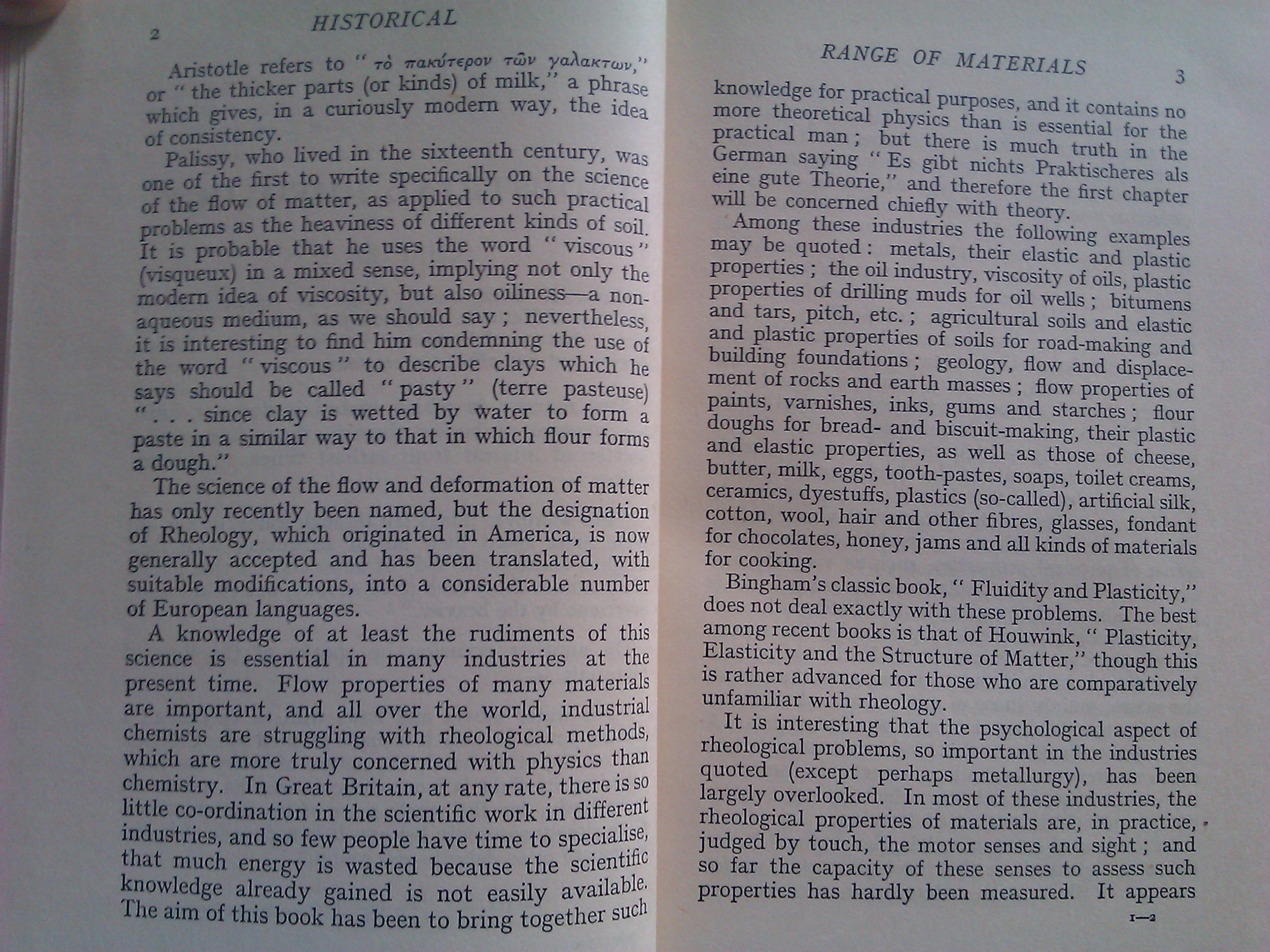str (139)

w H1ST0RICAL
Aristotle refers to " to iraiojrepov rćov ya\aKTcuv,' or " the thicker parts (or kinds) of milk," a phrase which gives, in a curiously modern way, the idea j of consistency.
Palissy, who lived in the sixteenth century, was I one of the first to write specifically on the science of the flow of matter, as applied to such practical problems as the heaviness of different kinds of soil. | It is probable that he uses the word f Yiscous” I (visqueux) in a mixed sense, implying not only the I modem idea of viscosity, bnt also oiliness—a non- I aqneons medium, as we should say; =sievertheless, it is interesting to find bim condemning the use of I the word " yiscous ” to describe clays which he I says should be called “pasty” (terrel pasteuse) I "... sińce clay is wetted by Water to form a pastę in a similar way to that in which flour forms a dough.”
The science of the flow and deformation of matter |l has only recently been named, but the d&ignation of Rheology, which originated in America, is mow I generally accepted and has been translated, ®dth II suitable modiflcations, into a considerable number ■ of European languages.
A knowledge of at least the rudiments^nf^this I science is essential in many industries at the KI present time. Flow properties of many nfeterials ■ are important, and all over the world .Bpidnstrial |i| chemists are struggling with rheological methods, which are morę truły concerned with physics than ■ chemistry. In Great Britain, at any ratę; there is so II little co-ordination in the scientific work i© di-Serent 11 industries, and so few people have time tdSpecialise, i that much energy is wasted because th^^pentific I knowledge already gained is not easilyi iayailable., The aim of this book has been to bring together such I
knowledge for practical purposes, and it contains no morę theoretical physics than is essential for the practical man; but there is much truth in the German saying " Es gibt nichts Praktischeres ais eine gute Theorie,” and therefore the first chapter will be concemed chiefly with theory.
Among these industries the following examples may be ąuoted: metals, their elastic and plastic properties ; the oil industry, viscosity of oils, plastic properties of drilling muds for oil wells * bitumens and tars, pitch, etc.; agricultural soils and elastic and plastic properties of soils for road-making and buildmg foundations; geology, flow and displace-ment of rocks and earth masses ; flow properties of paints, vamishes, inks, gums and staxch.es; flour doughs for bread- and biscuit-making, their plastic and elastic properties, as well as those of cheese, butter, milk, eggs, tooth-pastes, soaps, toilet creams, ceramics, dyestuffs, plastics (so-called), artificial silk, cotton, wool, hair and other fibres, glasses, fondant for chocolates, honey, jams and all kinds of materials for cooking.
Bingham’s classic book,*' Fluidity and Plasticity,” does not deal exactly with these problems. The best among recent books is that of Houwink, “ Plasticity, Elasticity and the Structure of Matter,” though this is rather advanced for those who are comparativeły unfamiliar with rheology.
It is interesting that the psychological aspeet of rheological problems, so important in the industries ąuoted (except perhaps metallurgy), has been largely overlooked. In most of these industries, the rheological properties of materials are, in practice, judged by touch, the motor senses and sight; and so far the capacity of these senses to assess such properties has hardly been measured. It appears
i—a
Wyszukiwarka
Podobne podstrony:
lnnovative use of Information from CRM systems to create strategie actions ofcompanies on the market
47181 Unit 6 (gr A , strona 4) 3 4 5 a— I’m going to cali her tomorrow. We’ve already met. I don’t
18780 str 138 139 Owa „pierwsza wojna” to wojna polsko-rosyjska w 1792 roku, prowadzona w obronie Ko
Because all relevant settings can be madę using the web interface, this manuał refers to configurati
page0149 139 dzam się na to, przemieszczania się drobin, które tańczą w sposób zawiły; ruch ten post
Str. 599PRO CHRISTO—WIARA I CZYN Katolicki, to znaczy powszechny, to znaczy, ściślej biorąc, kościel
13759 Str A O TAK-. ZADOWOLILI MNIE ay TO ŹLE? A HOŻE NIE POWINNI, W SĄ CZARNI? KOLOR SKOR
15554 str 090 czopem i panwią, jak to pokazano na rys. 13.1. Zgodnie z rys. 13.1 moment oporu tarcia
20719 str (142) X PREFACE I have attempted to make the bibliography as wide as possible, especially
więcej podobnych podstron